Hometown History: Port Jefferson’s forgotten storm — The Great Atlantic Hurricane of 1944
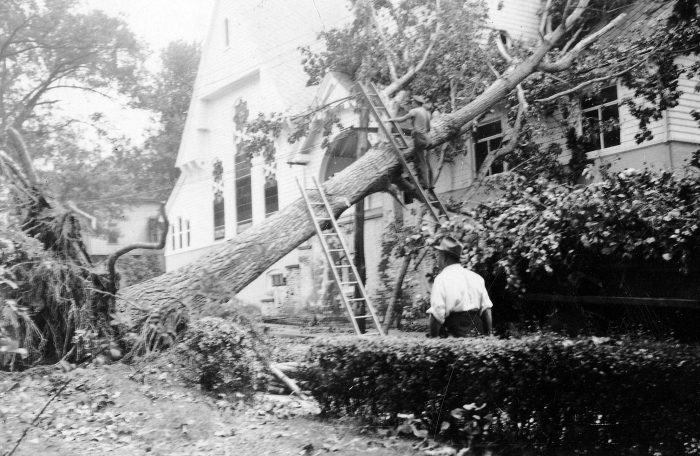
Port Jefferson is no stranger to hurricanes, having been pummeled by the big blows several times in its past. But while most villagers are familiar with named storms such as Carol and Donna, few are aware of the powerful Great Atlantic Hurricane of September 1944 and its impact locally.
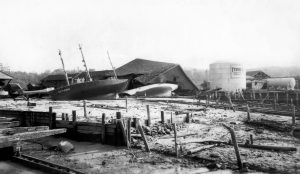
World War II was the news in 1944, not the weather, relegating stories about an otherwise major storm to the back pages. In addition, the United States was sensitive about releasing information that could benefit the enemy, such as revealing that a defense plant had been battered by wind and wave. With little or no media coverage, the Great Atlantic Hurricane became a forgotten storm, but not by those in Port Jefferson who had experienced its fury.
The hurricane arrived in the village on Thursday, Sept. 14, about 5 p.m., beginning with torrential rains, but did not become a full force storm until about 10:30 p.m. when wind velocities ranged from 75 to 85 mph.
The gusts, combined with a normal flood tide, drove whitecaps from Long Island Sound into Port Jefferson Harbor and over the village’s shorefront, inundating some areas with more than two feet of seawater.
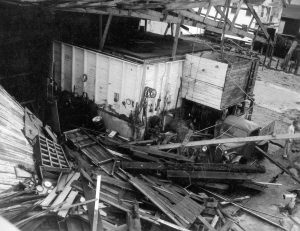
Surf Avenue (East Broadway) was particularly hard hit. The hurricane wrecked the lunchroom and gift shop at Bayles Landing, destroyed the Long Island Ice Company’s refrigeration plant, tore off the back of the Keystone Coal Company’s building, blew away the planking at the Standard Oil Company’s dock, and lashed what was once Wilson’s Sail Loft.
The bulkhead was undermined, plantings were washed away and the pavilion was damaged at Brookhaven Town’s new waterfront park, now Mary Bayles Park, which had been completed just days before the storm.
Seawater entered the Harborview Hotel, covering the ground floor, and the Vandall Building, bringing muck and mud into the Port Jefferson Service Club, a hospitality center for America’s uniformed military personnel.
But Surf Avenue was not the only area in Port Jefferson to feel the hurricane’s savage force. On West Broadway, the storm hammered the South Bay Water Company’s pumping station, the Tydol Oil Company’s pier and the Bridgeport and Port Jefferson Steamboat Company’s freight office. Six yachts stored at the Port Jefferson Shipyard were driven ashore and a building was demolished.
The proprietor of Teddy’s Hotel at the foot of Main Street reported that 36 to 40 inches of water had flooded his cocktail lounge and dining room. In nearby stores, basements were submerged, the deluge spreading up to the police station on Arden Place. At Bishop’s Garage on the corner of Main Street and West Broadway, cars were ruined as seawater fouled their engines.
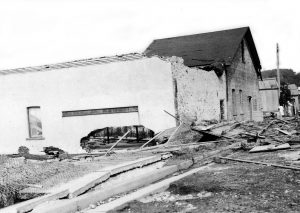
On the west side of the village, a large oil storage tank was toppled at the Swezey Coal and Feed Company’s property on Beach Street. Numerous boats sank in the yacht basin and small craft were later found along area beaches and in the salt meadow off West Broadway, blown far from their original locations.
Trees and utility poles were downed by the hurricane, taking out electric and telephone lines throughout Port Jefferson. On the corner of Main and Spring streets, one old tree cut wires as it crashed against the Methodist Church, but miraculously spared the building from serious damage. Two weeks after the storm, the village was still without full electric service.
The Port Jefferson Fire Department performed tirelessly throughout the emergency, pumping out flooded cellars in the village’s homes and businesses. The dedicated volunteers also provided electric generators at lightless Mather Memorial and St. Charles hospitals.
With so many draft-age men serving in the armed forces, younger citizens assisted police and highway departments in the days following the hurricane. The Minute Men Cadets, a unit of the Suffolk County Sheriff’s office, patrolled downtown Port Jefferson’s darkened streets, protecting property from looters and vandals. Members of the Junior Auxiliary Brookhaven Town Police Department directed traffic in the village and cleared debris from its clogged roads.
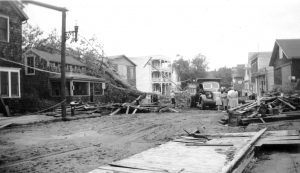
Although it would be tempting to compare the 1944 storm with other hurricanes that have walloped Port Jefferson, the effect of World War II on the village must be considered, making ranking difficult. For example, was power restored slowly in Port Jefferson because of the widespread damage resulting from the 1944 storm, wartime labor shortages, or both? Regardless, the Great Atlantic Hurricane was hardly a “forgotten storm” among villagers who had lived through the harrowing event.
Kenneth Brady has served as the Port Jefferson Village Historian and president of the Port Jefferson Conservancy, as well as on the boards of the Suffolk County Historical Society, Greater Port Jefferson Arts Council and Port Jefferson Historical Society. He is a longtime resident of Port Jefferson.






